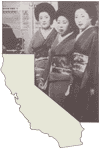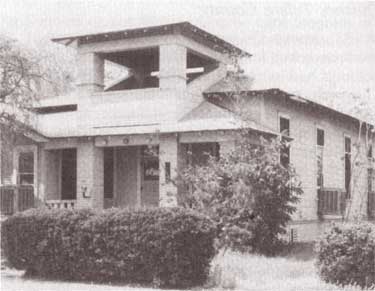![]()

Five Views: An Ethnic Historic Site Survey for California
MENU
Introduction
Immigration
Settlement
Organizations/Religion
Discrimination
World War II Incarceration
Historic Sites
Selected References

A History of Japanese Americans in California:
HISTORIC SITES
Buddhist Church of Bakersfield
Bakersfield, Kern County
The Buddhist Church of Bakersfield is a one-story, light gray clapboard structure. Double doors lead directly into the chapel area, and a door off the porch to the south leads to a hallway that runs between the meeting room to the north, and to six small rooms to the south. A short, tower-like appendage above the porch is formed by the porch columns which extend through the porch roof.
The large main room has a tatami floor covered by canvas-like material, on which the judo dojo practices. A screen toward the back of the room closes off the Buddhist altar. Walls are plaster, but the ceiling in the large main room has been covered with plywood. The small rooms off the hallway are used as office space and dressing rooms for the judo dojo.
The church altar, the oldest in the United States, was disassembled and shipped to Bakersfield from Japan, then reassembled and installed in the church. It is a fine example of the craftsmanship employed in construction of a religious altar without the use of nails.
A small rock garden is found at the northeast corner of the building, along with bamboo plants, trees, and shrubs.
The Bakersfield Buddhist Church and the St. Andrews Methodist Church are the last institutional remnants of a once-thriving Japanese community in this area where more than 400 Japanese once lived.
The Hokubei Tosa Taikan states that the first Japanese arrived in Bakersfield in 1889, when 60 laborers were hired by the Kern County Land Company through a labor contractor. These laborers eventually left the area, and the land company hired a few Japanese directly. Sutematsu Murakami and Kohei Tanaka were among these laborers. Murakami opened the first Japanese store, a bambooware store, in 1899. Three prostitutes were reported to be the only Japanese women in town in those days.
The discovery of oil in 1896 increased the demand for laborers. Enough Japanese laborers worked for the Santa Fe Railroad to justify construction of a labor camp for them. Taro Onodera was the supervisor, and 40 laborers worked for him. Wages were generally higher than anywhere else in California due to the remoteness of the area, the demand for laborers, and the high cost of living.
By 1911, Japanese lived in the vicinity of Bakersfield's Chinatown, which was located on 19th, 20th, and 21st streets, and on L and M streets. Japanese owned businesses included three restaurants, three inns, four billiard parlors, two barber shops, one Japanese restaurant, two stores, and one bathhouse.
Another account indicates that Kitaro Miyaji became supervisor of an 800-acre vineyard in Bakersfield. Ten Japanese laborers accompanied him to Bakersfield in 1904. A few years later, Miyaji and few others rented land for growing vegetables and raising pigs. In 1911, Mr. Kinoko is reported to have purchased the first land in this area.
In February 1909, the Young Buddhist Association was formed with 70 charter members, to fulfill religious as well as social needs. Regular meetings were held on Sundays at a house rented at 2202 M Street, with two charter members, Tadaichi Tomisa and Akitaro Uyeoka, contributing $7.00 a month to defray expenses.
The church at the present site was completed in June 1911, at a cost of $3,314.50. In addition to church services, a Japanese-Language School was established in the 1920s. Baseball, basketball, track and field, and other sports events were also offered to the congregation. In 1934, the Bakersfield Young Men's Judo Association was organized in the church, to "promote the spirit of the samurai" among nisei; the Judo Association was organized by Mr. Yuzawa and Rev. Ryujo Nagoya.
During the World War II internment period, the Buddhist Church was used as a storage facility for belongings of church members who were interned at Poston, Arizona. Neighbors kept watch over the building to protect it against vandalism. Mrs. Emma Buckmaster, an elementary school teacher, had the keys to the building, and shipped possessions to the camp as needed.
After the war, the church served as a hostel, with as many as 20 persons accommodated here at one time. In 1956, the church was reorganized. Membership was down to 10 families, and the church no longer had a resident minister. Ministers from the Visalia Buddhist Church traveled to Bakersfield for monthly services and observances of religious holidays.
Through the years, the judo club has remained active, and still practices on a regular basis, as well as participating in tournaments.
Current urban redevelopment plans by the City of Bakersfield threaten this structure. A shopping center is planned, which would displace all the buildings in the vicinity. Concern for the church's survival relates not only to the structure, but to the altar which was brought from Japan. If redevelopment cannot be halted, it is hoped that the building will be moved out of the area, and that careful plans will be made so the altar can be conveyed to another site without being damaged.

Bakersfield Buddhist Church, Bakersfield, Kern County
NEXT> Bowles
Last Modified: Wed, Nov 17 2004 10:00:00 pm PDT
http://www.cr.nps.gov/history/online_books/5views/5views4h7.htm
![]()
 Top
Top